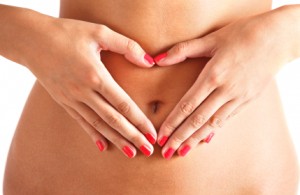It can be quite frustrating if you are trying to get pregnant, yet have no period. Having a healthy cycle is step one for boosting your fertility naturally and being able to get pregnant. There is a myriad of reasons your cycle may be irregular such as stress, dietary deficiencies, low body weight, getting off of birth control pills, hormonal imbalance, perimenopause or other underlying issues.
Since the lining of the uterus is not being shed, it is very important to clear out the old blood and establish a healthy cycle again. This can be done naturally and effectively with herbs and nutrition. I have talked with many clients who have been offered synthetic estrogen to get their period going again… taking synthetic estrogen for this issue is like using a sledge hammer on a thumb tack.
Absent Period… Otherwise Known as Amenorrhea
Absent period is known as amenorrhea. Amenorrhea is divided into two distinct groups: primary amenorrhea and secondary amenorrhea, with secondary amenorrhea being the most common.
Note: Absent menstrual cycles due to perimenopause and menopause are not considered amenorrhea.
Primary Amenorrhea
Defined as the absence of menstruation by the age of 14 with no secondary sexual characteristics, or the absence of menstruation by the age of 16 regardless of secondary sexual characteristics. Examples of secondary sexual characteristics in women are enlargement of breasts, widening of hips, armpit, pubic and leg hair and body odor. Primary amenorrhea is uncommon, happening in about only 0.3% of women.
Often natural therapies do not work as well for women with primary amenorrhea because there is usually an underlying developmental issue for those women. In the case of primary amenorrhea, it may be best to find a reproductive endocrinologist to work with. We are not saying natural therapies and herbs will not work for primary amenorrhea, just that this condition is more difficult to work with. It is still very beneficial to eat well and choose healthy lifestyle practices.
Secondary amenorrhea
Defined as the absence of menstruation for the total of at least 3 previous menstrual cycle lengths, or at least 6 months in a woman who previously had a menstrual cycle and is still in her reproductive years. Reproductive years are defined as menarche, when a woman begins her menstrual cycle in puberty, until menopause, which happens around the ages of 40-55. Secondary amenorrhea is more common than primary amenorrhea.
Click here to learn about RejuvaFlow by Fertilica™
Causes of Absent Period
A menstrual cycle that has stopped is not a disease, it may be a sign that there is an underlying imbalance in the body. A regular menstrual cycle is regulated by a complex system of messages and actions orchestrated by the endocrine system. The endocrine glands work together to send messages via hormones. This is called the feedback loop.
In very simple terms the hypothalamus produces GnRH (gonadotrophin-releasing hormones) which signals to the pituitary to produce LH (luteinizing hormone) and FSH (follicle stimulating hormone) to signal to the ovaries that it is their turn to release estrogen and progesterone, which is recognized by the pituitary gland.
Simple right? Not so. As you can see a healthy cycle is dependent on each part of the feedback loop functioning properly. Think of it as an orchestra; if just one part of the cycle is off, it will throw the entire cycle off, causing imbalances that can affect regular menstrual cycles.
Nutritional Deficiencies
Sometimes the body is not getting enough nutrition daily to be able to sustain normal functions, including the menstrual cycle. There are many very important nutrients the body requires to maintain a healthy menstrual cycle. Nutritional deficiencies can actually cause menstrual cycle irregularities and eventually may cause the entire cycle to stop.
What you eat daily makes up every part of your body. You are what you eat!
Learn how to eat a healthy whole food fertility diet! Harvard performed a recent study that showed an 80% decrease in infertility with the lifestyle changes made by switching to a fertility diet. Women who followed a combination of five or more lifestyle factors, including changing specific aspects of their diets, experienced more than 80 percent less relative risk of infertility due to ovulatory disorders compared to women who engaged in none of the factors.

Eating a wide variety of whole foods is vital to a healthy menstrual cycle. The body relies on the foods we consume daily to function at its best. There are key nutrients and foods that support a healthy menstrual cycle; if any of these are lacking there may be a deficiency that may be contributing to an absent period. Be sure you are getting enough of the following…
Iron: Studies have shown that women who do not get sufficient amounts of iron may suffer anovulation (lack of ovulation) and possibly poor egg health, which can inhibit pregnancy at a rate 60% higher than those with sufficient iron stores in their blood, according to researchers from Nova IVI Fertility Centre and Jaya College of Arts and Sciences in India, as published in 2014 in the International Journal of Current Research and Academic Review.
Foods rich in iron are divided into two groups heme and nonheme. This simply means it comes from an animal source or a non-animal source. Heme iron sources are grass fed, free-range organic bison, chicken, eggs, elk, beef, and wild caught Alaskan salmon. Nonheme iron-rich foods include blackstrap molasses, pumpkin and sunflower seeds, beans, nettles, amaranth, dark leafy greens, Turkish apricots (unsulphured), seaweed, and quinoa.
In their book The Fertility Diet, Jorge Chavarro, MD and Walter C. Willett, MD reveal, from the landmark Nurses’ Health Study, research proving that food can boost fertility. About iron in particular Chavarrio and Willett share, “In a study of women who were having ovulation problems, 40% became fertile after supplementing with iron.”
Vitamin C: Vitamin C may improve hormone levels and increase fertility in women. The body requires food sources of vitamin C for proper iron absorption, so be sure to eat a food high in vitamin C when consuming a food high in iron. Great food sources of vitamin C are red bell peppers, oranges, strawberries and hibiscus flower tea.
B Vitamins: Green vegetables are rich in B vitamins which are necessary for proper hormonal balance. Think of Swiss chard, kale, watercress, seaweed, spirulina, collard greens, nettles, parsley and basil!
Essential fatty acids: EFA’s are important for hormone production. Many women are low in EFAs, specifically omega 3. Some foods rich in EFAs are flaxseeds, walnuts, salmon, sardines, halibut, shrimp, snapper, scallops, chia seeds and cod liver oil.
Cholesterol: Cholesterol is necessary for hormone production. Avoid eating a ‘low-fat’ diet and make sure to eat a diet that includes whole fat animal products sourced from grass-fed animals. Foods rich in clean cholesterol: grass-fed beef, raw milk from grass-fed cows or goats, whole milk yogurt and kefir, free-range/pastured eggs, butter from grass-fed milk (Kerry Gold is a common one), and coconut oil.
Fiber: Fiber helps to remove excess hormones from the body which may be causing hormonal imbalance. Fiber also helps to regulate the blood sugar levels, which helps to reduce fertility issues such as PCOS and immunological issues, and promotes healthy hormonal balance. Some examples of high fiber foods are fresh fruits, vegetables, dark leafy greens, and beans.
Zinc: This is just one of the minerals that the body uses to keep hormone levels (like estrogen, progesterone and testosterone) stable throughout the entire menstrual cycle. A woman’s body needs a certain amount of zinc to produce mature eggs that are ripe for fertilization. The richest sources of zinc are oysters, raw pumpkin seeds, sesame seeds, and tahini (a.k.a. sesame seed butter).
A great way to support the body in getting all the necessary nutrients it needs daily is to take a whole food multivitamin. Including a whole food multivitamin, along with eating a fertility diet, is one of the first steps in getting your period back!
Being Overweight or Underweight
There is a direct link between anovulation and obesity. Body fat cells, called adipocytes, produce estrogen. Obese women may have too much estrogen due to too much body fat. Women who are underweight may also have anovulation due to lack of body fat. There may not be enough estrogen or adequate cholesterol levels being maintained to support the menstrual cycle. Studies out of Norwegian University of Science and Technology and the University of North Carolina have shown that women with extreme exercise habits have significantly lower levels of estradiol due to low levels of body fat in key areas of the body, leading to anovulation. We share dtudy details in our guide Is Exercise Good Or Bad For Fertility?.
Estrogen is essential for healthy bone formation, healthy gene expression, maintaining healthy cholesterol levels, and is vital for a healthy menstrual cycle. Too much estrogen, or too little in the body may cause the feedback loop to not function properly and the menstrual cycle may cease. Now you can see why it is so important to have adequate amounts of body fat; not too much and not too little!
PCOS
Polycystic ovarian syndrome, sometimes also called polycystic ovarian dysfunction, is the most common endocrine disorder in women of reproductive age. There are two distinct and consistent features of PCOS: absent periods or inconsistent menstrual cycles and hyperandrogenism (the body is producing too many androgens, the most common one being testosterone).
Stress
Stress may cause the body to stop the menstrual cycle. Stress causes the body to release stress hormones like cortisol and adrenalin that prevent our fertility hormones from being released at the correct times in the menstrual cycle. This can cause a disruption in the menstrual cycle by affecting how the adrenal glands function. Reducing stress and supporting adrenal health is essential to a healthy menstrual cycle and is a relatively easy fix for healthy fertility. The adrenal glands also directly impact thyroid health.
Thyroid issues
Poor thyroid function may cause the menstrual cycle to stop. An overactive thyroid that produces too many thyroid hormones is called Hyperthyroidism. Hypothyroidism is when the thyroid is underactive and does not produce enough thyroid hormones. An absent menstrual cycle is a sign of hyperthyroidism, where irregular or heavy cycles may be a sign of hypothyroidism.
Pituitary tumor
A pituitary tumor may cause disruption in the release and manufacturing of certain hormones which may cause the menstrual cycle to stop.
Premature Ovarian Failure
POF, also known as Ovarian Hypofunction, is defined as a loss of normal ovarian function before the age of 40. The menstrual cycle may cease before the age of 40, or become sporadic. This means that menopause comes earlier than normal.
Perimenopause and Menopause
Perimenopause is the time leading up to menopause. As perimenopause progresses toward menopause, it is normal for menstrual cycles to become irregular and for hormone levels to fluctuate. The menstrual cycle may become absent for many cycles and then suddenly come back for a couple cycles, and then goes away again, becoming sporadic for some years. As ovarian reserve diminishes and egg health declines, FSH levels rise and the menstrual cycle will become more and more irregular, until eventually it stops.
Menopause is defined as absent menstruation for a year or longer. Menopause may also be confirmed by elevated FSH levels between 60 to 100mL/L on two tests done at least 1 month apart, and/or LH levels greater than 50mIU/L and estradiol levels less than 50pg/mL. Natural therapies cannot reverse the aging process or bring back the menstrual cycles in a woman who has already gone through, or is going through menopause.
When to see a doctor!
If you have not had a menstrual period for 3 consecutive cycles or more, it is time to make an appointment with your healthcare practitioner. They can help you to determine what the causes may be. Most medical doctors will often prescribe oral contraceptives (birth control pill) to get the menstrual cycle to regulate. It is important to realize that this method will force the body to have a cycle and prevent pregnancy. Oral contraceptives do not solve the problem of why the menstrual cycle is absent to begin with. Luckily there are natural therapies such as herbs, specific massage techniques, supplements, stress reduction techniques, and dietary changes than can help support the body in regulating the menstrual cycle in most cases.

Herbs to Promote Menstruation
Before heading right for herbs that are known to help bring back the menstrual cycle (emmenagogues) it is also important to consider herbs that support healing of the cause of the absent menstrual cycle. Why is it you are not having a period to begin with? Once you know what is causing this to happen, you will be able to formulate a plan for yourself. This is vital when desiring to use herbs as well. For example, there are herbs that support hormonal balance through endocrine system support, some that help the body to respond to stress and others that have a direct action on the uterus.
Important caution: It is extremely important to rule out pregnancy prior to beginning any herbs for fertility, especially those used to bring back a menstrual cycle. Most herbs that help to regulate the menstrual cycle are not safe for pregnancy.
Herbs to Bring on Menstruation
The following herbs may help to bring on a menstrual period. All the herbs in this section will only be effective if the menstrual period is absent due to hormonal imbalance. If the menstrual cycle is absent due to nutritional deficiencies, these herbs may not be as effective. It is very important that dietary changes are in place before beginning any herbs to bring back the menstrual cycle.
Black Cohosh root (Actaea racemosa)
Black cohosh has been used for hundreds of years to help bring back the menstrual cycle. Black cohosh promotes regulation of the entire menstrual cycle while helping to support a calm uterus.
Dong Quai root (Angelica sinensis)
This is the main herb for this issue. Dong Quai works by promoting blood flow to the pelvis where it helps support the body to bring back an absent period. It does this by nourishing the blood (it is in nearly all Chinese herbal blood-building formulas because it is iron rich), improving hormonal regulation, and aiding in uterine tone.
Motherwort aerial parts (Leonurus cardiaca)
This herb is very effective at reducing uterine muscle spasm and cramping and improving uterine tone. Motherwort has been found to mildly stimulate the uterus, while also aiding the uterus to work efficiently, which is helpful in bringing on menstruation.
White Peony (Paeonia officinalis)
This herb helps build the blood and increase circulation to the reproductive organs. Overall, White Peony provides excellent hormone balancing support and aids in pain reduction and relaxation. White Peony moves the blood in the pelvic area, offering support for uterine stagnant conditions including absent period.
Since it can be challenging to source all of these herbs in the proper ratios, the team of Natural Fertility Specialists at Natural Fertility Info.com created a formula specifically to address this need.
We have been receiving great results and feedback from the Rejuvaflow formula. Click here for more information.
Herbs to Promote Regular Menstrual Cycles
The following herbs would be used once the first menstrual period comes back or after performing a Fertility Cleanse.
Shatavari (Asparagus racemosus)
Shatavari helps to promote regular menstrual cycles by aiding in regulation of estrogen levels. Shatavari is also an adaptogen that supports endocrine system function for healthy hormonal balance.
Tribulus (Tribulus terrestris)
This herb has been shown to normalize ovulation in infertile women. Tribulus supports healthy hormone levels, is a known female reproductive system tonic, and may increase libido.
Vitex (Vitex agnus-castus)
Vitex is another great herb for amenorrhea due to hormonal imbalance. It helps to balance the hormones while not containing any hormones within the herb itself. Vitex supports hormonal balance in the body by having an effect on the hypothalamic-pituitary-ovarian axis (hormonal feedback loop), correcting the problem at the source. Numerous botanical/herb books report clinical data and studies showing the effectiveness of vitex for all types of menstrual cycle irregularities when used for many months consistently.
Vitex has been found to help normalize ovulation, improve a short luteal phase, support healthy hormone levels, and reduce Polycystic Ovary Syndrome (PCOS).
In her book Botanical Medicine for Women’s Health, Physician, Midwife, and Herbalist Dr. Aviva Romm and Registered Herbalist Bevin Clair, MS, CHS share of reports showing that Vitex can be extremely helpful in bringing back the menstrual cycle in women with absent periods due to eating disorders and lack of menstruation due to breastfeeding. We do not advise weaning a baby until they are over a year old. For mothers of older babies who are ready to try to conceive again, and still have yet to begin menstruating, vitex may be an option.
If you have not had a menstrual cycle for two or more months, you may want to consider performing a Fertility Cleanse. Fertility cleansing helps to cleanse the uterus of old blood and tissues while helping the liver to get rid of excess hormones to promote a healthy menstrual cycle. If after doing a Fertility Cleanse your period still does not come back and you have implemented a nutrient dense fertility diet, consider herbs to bring back the menstrual cycle.

Self Fertility Massage
A uterus that is not stimulated to shed the endometrium, or sheds the endometrium inadequately each month, may become atrophied. This means the muscles lose their tone and strength. If the mucosa lining known as the stratum functionale is not stimulated to secrete mucus and build up the endometrium, then the uterus is not lubricated and may become “dry” and weak. You can see why this would not be the best environment to house an embryo. Having a regular menstrual cycle is essential to having a healthy uterus.
Here’s how Self Fertility Massage aids the body in regulating menstrual cycles:
- Promotes hormonal balance*
- Helps to reduce stress and stress hormones*
- Improves communication within the endocrine system*
- Increases circulation to the uterus, ovaries, and fallopian tubes*
- Promotes the movement of fluids*
- Helps the body to rid itself of old stagnant blood and tissues*
Learn all about how Self Fertility Massage may help to promote a healthy menstrual cycle here…
Summary
Overall, it is extremely important to begin by nourishing the body through good nutrition. Your dietary habits are your foundation; without that in place first, the body is not going to respond to herbs for amenorrhea as well. Second, be sure to include a good whole food multivitamin, reduce stress and exercise regularly. Third, consider an herbal program for getting the menstrual cycle back on track. Last, but not least, practice fertility massage regularly. This combination is a great plan for working to promote a healthy menstrual cycle long-term! Be patient, the body needs time to establish a cycle. Be gentle with yourself and your body will come back into balance.
- What Is Amenorrhea? (n.d.). Retrieved from https://www.webmd.com/infertility-and-reproduction/guide/absence-periods
- S.Sasikumar, J.Shyam, Sundar, D.Dakshayani, R.Prabavathy, and M.KarthikaInt. J. Curr. Res. Aca. Rev. (2014); 2(2): 96-115. A study on significant biochemical changes in the serum of infertile women. Retrieved from http://www.ijcrar.com/vol-2-2/Sasikumar%20Sathiyanarayanan,%20et%20al.pdf
- Chavarro, J.E., Rich-Edwards, J.W., Rosner, B.A., Willett,W.C. (Nov. 2007). Diet and Lifestyle in the Prevention of Ovulatory Disorder Infertility. Obstetrics & Gynecology Volume 110 – Issue 5 – pp 1050-1058. doi: 10.1097/01.AOG.0000287293.25465.e1 Retrieved from: https://www.researchgate.net/publication/5868700_Diet_and_Lifestyle_in_the_Prevention_of_Ovulatory_Disorder_Infertility
- Chavarro, J.E., Willett, W., & Skerrett, P.J. (2009). The fertility diet: Groundbreaking research reveals natural ways to boost ovulation & improve your chances of getting pregnant. New York: McGraw-Hill.
- R E Frisch, R C Snow, L A Johnson, B Gerard, R Barbieri, and B Rosen. Magnetic resonance imaging of overall and regional body fat, estrogen metabolism, and ovulation of athletes compared to controls. The Journal of Clinical Endocrinology & Metabolism August 1, 1993 vol. 77 no. 2471-477. DOI: http://dx.doi.org/10.1210/jcem.77.2.8345054
- Hudson, T. (2008). Polycystic Ovarian Syndrome (PCOS). Retrieved from: http://drtorihudson.com/general/endocrine-health/pcos/polycystic-ovarian-syndrome-pcos/
- Romm, A., Clare, B. (2010). Amenorrhea. In Botanical Medicine for Women’s Health (pp. 122-130). St. Louis, Missouri: Churchill Livingstone/Elsevier.





